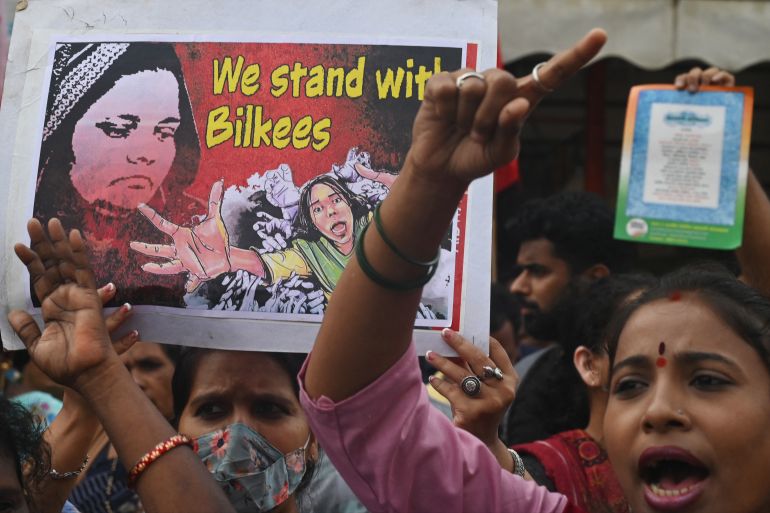How did India’s Supreme Court send Bilkis Bano’s rapists back to jail?
Modi’s government had helped set 11 convicted rapists free two years ago. But the top court said rules were violated in releasing them.

India’s Supreme Court on Monday restored life prison sentences for 11 men who had raped a Muslim woman, Bilkis Bano, during the communal riots in Gujarat in 2002.
The decision came after Bano and other petitioners challenged a decision by the Gujarat government, backed by Prime Minister Narendra Modi’s government, to set the convicted rapists free two years ago.
Keep reading
list of 4 itemsRapists freed: Is this how justice ends for Indian Muslims?
Bilkis Bano: ‘Give me back my right to live without fear’
India’s Modi government approved release of Gujarat rapists
Bano’s fight for justice over more than two decades had, for many Indians, become emblematic of the struggle of survivors of the 2002 violence to ensure that the guilty are punished.
Yet, when a Supreme Court bench gathered on Monday to declare its verdict in the case, it was unclear to the wider nation what it had decided — and what its rationale would be, months before India’s national elections in which religious polarisation is expected to play a central part.
So how did India’s top court decide to send the convicts back to jail? It starts with a woman’s struggle that has played out before all of India, through multiple twists and turns since a day of horror in the spring of 2002.
Who is Bilkis Bano?
Bano, now in her 40s, was five months pregnant in March 2002 when she fled her Randhikpur village in eastern Gujarat, alongside her relatives and other Muslims, as violence against the community broke out across the state.
Bano and her family had reached a district in the west of the state when a mob of several men attacked their group. She was gang-raped during the violence.
Seven of her family members were killed, including her three-year-old daughter, whose head was smashed on the ground by the perpetrators in Gujarat’s Dahod district.
During the killings in Gujarat, nearly 2000 people, mostly Muslims were murdered. Modi was the chief minister of Gujarat during this time and has faced allegations since then that his government facilitated the violence. Modi has repeatedly denied having any role and the Supreme Court has said it found no evidence to prosecute him.
In December 2003, the Indian Supreme Court ordered a federal investigation into the Bilkis Bano rape case by the Central Bureau of Investigation (CBI). In 2004, the accused were arrested as the Supreme Court ordered the trial to be transferred from Gujarat to the neighbouring state of Maharashtra after Bano alleged death threats from the accused.
A court convicted 11 accused in 2008, sentencing them to life imprisonment on the charge of gang rape and murder.
In 2019, after a 17-year legal battle, it seemed like Bano had finally secured justice when the Supreme Court directed the Gujarat government to pay $71,000 to Bano as compensation, along with a job and accommodation of her choice.
But only three years later, on India’s Independence Day, the government approved the release of the 11 men who were arrested. When they were freed, they were garlanded.
Why were the convicts released?
The convicts were released as ordered by Gujarat’s state government on the basis of its remission policy that has existed since 1992.
At the time of their release, officials in Gujarat, where Modi’s Bharatiya Janata Party (BJP) holds power, had said the convicts were granted remission because they had completed over 14 years in jail.
Lawyer Vrinda Grover told Al Jazeera that a new policy that came into effect in 2014 prohibits the remission of those convicted for certain crimes, including rape and murder. This policy “looking into the gravity of certain offences makes convicts ineligible for remission”, she said.
More specifically, “it specifies that persons convicted for the murder of two or more persons, or murder with gang rape were ineligible for grant of remission”, said Grover.
However, Grover said, because the 11 men were convicted in 2008, the 1992 policy would apply rather than the 2014 one because the latter had not come into effect during the time of their conviction.
The decision shook Bano’s faith in justice. “How can justice for a woman end like this? I trusted the highest courts in our land,” she said in a statement in 2022, adding that no authorities reached out to her before making the decision. “Please undo this harm. Give me back my right to live without fear and in peace.”
Indeed, the Supreme Court found that authorities had violated another rule in setting the convicts free in its January 8 order, in which it ordered them to surrender to prison officials in Gujarat within two weeks.
Why did the Supreme Court rule against the convicts’ freedom?
Grover explained that the remission was overruled because the Indian top court had transferred the case from the state of Gujarat to Maharashtra.
Section 432 of India’s Code of Criminal Procedure empowers the “appropriate government” — which is the government of the state where the convicts were sentenced — “to remit the sentence by passing well-reasoned and speaking orders”.
Because the conviction happened in Maharashtra, the government of Gujarat acted beyond its powers in setting the men free. In theory, that also means that the state government of Maharashtra — also ruled by the BJP — could release the convicts.
But for now, Bano and her family are relieved.
Bano’s uncle and a witness in her case, Abdul Razzak Mansuri, told Al Jazeera the top court quashing the remission was a step towards justice for her.
“We are glad,” he said. “The Gujarat government released them [convicts] and it was very hurtful for us.”